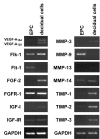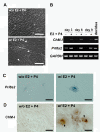Localization of chondromodulin-I at the feto-maternal interface and its inhibitory actions on trophoblast invasion in vitro
- PMID: 21849085
- PMCID: PMC3171719
- DOI: 10.1186/1471-2121-12-34
Localization of chondromodulin-I at the feto-maternal interface and its inhibitory actions on trophoblast invasion in vitro
Abstract
Background: Chondromodulin-I (ChM-I) is an anti-angiogenic glycoprotein that is specifically localized at the extracellular matrix of the avascular mesenchyme including cartilage and cardiac valves. In this study, we characterized the expression pattern of ChM-I during early pregnancy in mice in vivo and its effect on invasion of trophoblastic cells into Matrigel in vitro.
Results: Northern blot analysis clearly indicated that ChM-I transcripts were expressed in the pregnant mouse uterus at 6.5-9.5 days post coitum. In situ hybridization and immunohistochemistry revealed that ChM-I was localized to the mature decidua surrounding the matrix metalloproteinase-9 (MMP-9)-expressing trophoblasts. Consistent with this observation, the expression of ChM-I mRNA was induced in decidualizing endometrial stromal cells in vitro, in response to estradiol and progesterone. Recombinant human ChM-I (rhChM-I) markedly inhibited the invasion through Matrigel as well as the chemotactic migration of rat Rcho-1 trophoblast cells in a manner independent of MMP activation.
Conclusions: This study demonstrates the inhibitory action of ChM-I on trophoblast migration and invasion, implying the potential role of the ChM-I expression in decidual cells for the regulated tissue remodeling and angiogenesis at feto-maternal interface.
Figures








Similar articles
-
Expression of the cartilage derived anti-angiogenic factor chondromodulin-I decreases in the early stage of experimental osteoarthritis.J Rheumatol. 2003 Oct;30(10):2207-17. J Rheumatol. 2003. PMID: 14528519
-
The cytokine gene CXCL14 restricts human trophoblast cell invasion by suppressing gelatinase activity.Endocrinology. 2009 Dec;150(12):5596-605. doi: 10.1210/en.2009-0570. Epub 2009 Oct 15. Endocrinology. 2009. PMID: 19833716
-
Suppression of T cell responses by chondromodulin I, a cartilage-derived angiogenesis inhibitory factor: therapeutic potential in rheumatoid arthritis.Arthritis Rheum. 2004 Mar;50(3):828-39. doi: 10.1002/art.20193. Arthritis Rheum. 2004. PMID: 15022325
-
Chondromodulin-I and tenomodulin: the negative control of angiogenesis in connective tissue.Curr Pharm Des. 2007;13(20):2101-12. doi: 10.2174/138161207781039751. Curr Pharm Des. 2007. PMID: 17627542 Review.
-
Chondromodulin-I as a novel cartilage-specific growth-modulating factor.Pediatr Nephrol. 2000 Jul;14(7):602-5. doi: 10.1007/s004670000339. Pediatr Nephrol. 2000. PMID: 10912526 Review.
Cited by
-
Chondromodulin-1 in health, osteoarthritis, cancer, and heart disease.Cell Mol Life Sci. 2019 Nov;76(22):4493-4502. doi: 10.1007/s00018-019-03225-y. Epub 2019 Jul 17. Cell Mol Life Sci. 2019. PMID: 31317206 Free PMC article. Review.
-
A Narrative Review of the Roles of Chondromodulin-I (Cnmd) in Adult Cartilage Tissue.Int J Mol Sci. 2024 May 27;25(11):5839. doi: 10.3390/ijms25115839. Int J Mol Sci. 2024. PMID: 38892027 Free PMC article. Review.
References
-
- Funaki H, Sawaguchi S, Yaoeda K, Koyama Y, Yaoita E, Funaki S, Shirakashi M, Oshima Y, Shukunami C, Hiraki Y. et al.Expression and localization of angiogenic inhibitory factor, chondromodulin-I, in adult rat eye. Invest Ophthalmol Vis Sci. 2001;42(6):1193–1200. - PubMed
-
- Hiraki Y, Inoue H, Iyama K, Kamizono A, Ochiai M, Shukunami C, Iijima S, Suzuki F, Kondo J. Identification of chondromodulin I as a novel endothelial cell growth inhibitor. Purification and its localization in the avascular zone of epiphyseal cartilage. J Biol Chem. 1997;272(51):32419–32426. doi: 10.1074/jbc.272.51.32419. - DOI - PubMed
Publication types
MeSH terms
Substances
LinkOut - more resources
Full Text Sources
Miscellaneous

